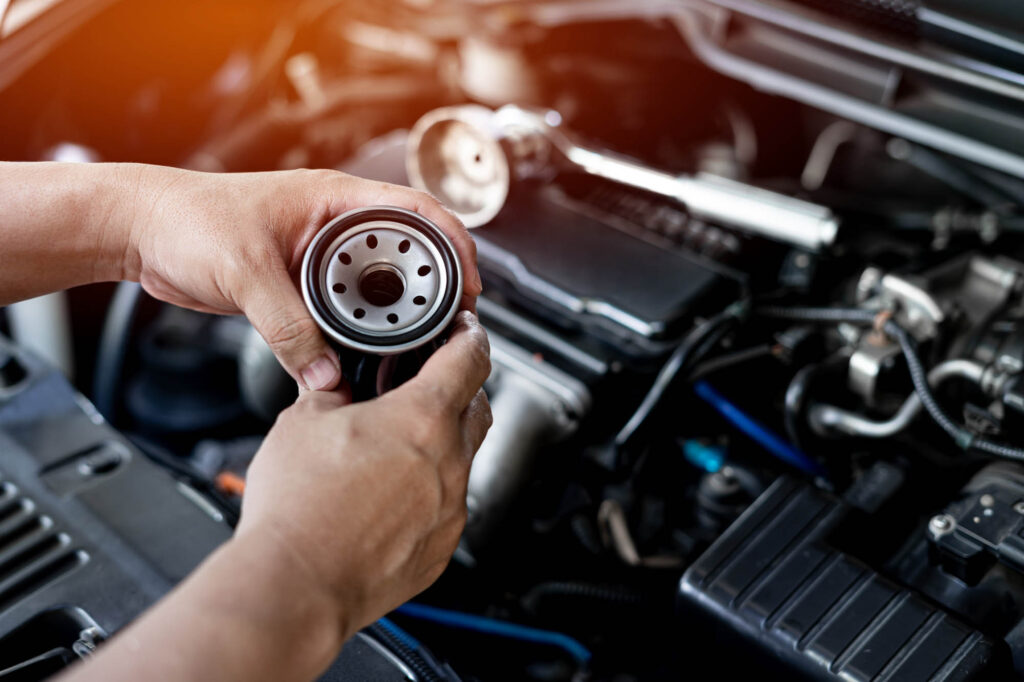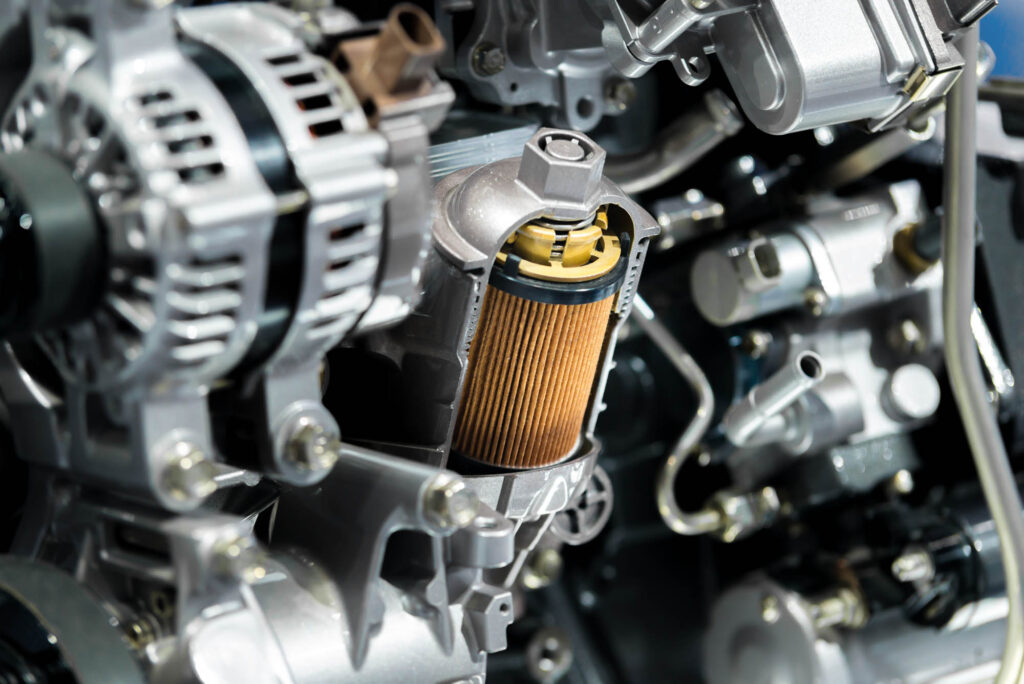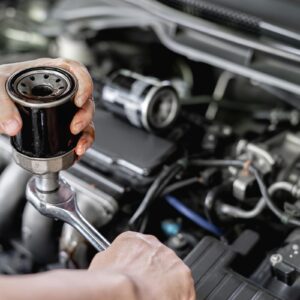There are two major types of car oil filters—primary oil filters and secondary oil filters.
Primary oil filters clean and remove impurities from the oil used in the engine. It is the most common type of oil filter, and there are two prominent primary oil filters:
- Cartridge oil filters are often made of either metal or fiber.
- Spin-on oil filters are comprised of steel canisters and paper elements.
On the other hand, secondary oil filters remove contaminants the primary oil filters failed to stop. There are three common types of secondary oil filters:
- Centrifugal oil filters trap even the tiniest contaminants with centrifugal force.
- Magnetic oil filters remove metallic impurities from oil with magnets.
- Thermal chamber oil filters heat up to boil off any oil contaminants.
If you’re keen on learning more about these oil filters, what they do, and how they work, then be sure to read on.
What Does an Oil Filter Do?

The oil filter is responsible for filtering and cleaning any oil that goes through it. It accomplishes this by trapping large particles, improving the overall quality of the oil that enters the engine.
Because oil particles are locked by the oil filter, impurities are removed and engine abrasion is reduced. As a result, engines tend to run better and last longer overall, improving their performance, reducing emissions, and cutting maintenance costs.
But how do oil filters work, exactly?
How Does an Oil Filter Work?
Whenever you drive your vehicle, oil that isn’t burned up continues to flow through your vehicle the same way your heart pumps blood throughout your body. The oil filter plays a role in this system too.
When oil circulates, it is pumped directly through the oil filter. Contaminants in the oil, both organic and inorganic, are trapped and removed. They are pushed through the filter membrane, and back into the central hole.
From here, the filtered oil enters the engine once more and the process repeats.
Bear in mind that if you’re looking for an aftermarket replacement oil filter for your vehicle, you need to make sure that the filter you pick matches the specifications of the OEM oil filter. If the OEM filter is supposed to filter at specific parts per million (PPM), check the PPM of the aftermarket filter and see if they line up.
Bear in mind that if you’re looking for an aftermarket replacement oil filter for your vehicle, you need to make sure that the filter you pick matches the specifications of the OEM oil filter.
–Anthony Harlin, ASE Certified Master Automobile Technician
Different Types of Oil Filters
There are two types of oil filters you must know about: primary oil filters, and secondary oil filters.
Primary Oil Filters
The first of the two most common types of oil filters is the primary oil filter, which is also known as the full-flow oil filter. These oil filters are responsible for filtering the majority of the contaminants in the oil.
There are two common types of primary oil filters: the cartridge oil filter, and the spin-on oil filter.
Cartridge Oil Filter
Cartridge oil filters are one of the simplest and most common oil filters available. The filters are often made of metal or fiber. Their unique mounting position makes them easy to drain and clean whenever you have a stuck oil filter.

Spin-On Oil Filter
On the other hand, spin-on oil filters are comprised of steel canisters with paper elements designed to catch contaminants. Because of the inexpensive paper materials, you’ll find it much easier to repair or change your oil filter.
Secondary Oil Filters
The second of the two most common types of oil filters is the secondary oil filter, which is also known as the bypass oil filter. Secondary oil filters clean up any contaminants the primary oil filters failed to catch. These filters specialize in catching finer debris.
The three most common types of secondary oil filters are the centrifugal oil filter, the magnetic oil filter, and the thermal chamber oil filter.
Centrifugal Oil Filter
Also known as spinner oil filters, centrifugal oil filters make use of centrifugal force to trap and capture contaminants in the oil. They move rapidly in a singular motion; the spinning pushes the contaminants to the bottom of the filter for easy removal.
Magnetic Oil Filter
Magnetic oil filters trap metallic contaminants found in oil with the help of magnets. Unfortunately, this means they aren’t as effective as removing other contaminants like dust or bacteria.
Thermal Chamber Oil Filter
Finally, thermal chamber oil filters are unique in how they dispose of contaminants by burning them until nothing remains. They also perform a secondary purpose: to raise the temperature of your oil so that it becomes less viscous, making it circulate through your vehicle more smoothly.
Oil Filter Membranes: What Do They Do?

Oil filter membranes, also known as oil filter media, are responsible for the filtration of contaminants in your vehicle’s motor oil. Whenever your vehicle circulates oil, it passes through the oil filters which catch and dispose of impurities.
These membranes effectively allow the oil filters to do their job: filtering. Because of this, it’s arguable the membrane is one of the most, if not the most, important component of any oil filter.
Different Types of Oil Filter Membranes
There are three different types of oil filter membranes, each made of different materials. The most common of these membrane types is the cellulose membrane, which also happens to be the cheapest and shortest-lived.
Cellulose Membranes
One of the most common oil filter membrane types is the cellulose membrane. These membranes can often be found in low-end and mid-end oil filters. Their low cost is attributed to their make and inconsistent pore sizes, comprised entirely of wood pulp with large fibers.
On average, a cellulose membrane is capable of cleaning up roughly 40% of motor oil particles. These membranes don’t have as much durability as others, so they tend to last up to 3,000 miles on average.
Micro glass Membranes
Another type of oil filter membrane includes micro glass membranes, which are considered to be the most advanced of all the membrane types. Microglass membranes are made up of an incredibly fine micro glass mesh that is ten times finer than the fibers used in cellulose membranes.
Because micro glass membranes are so advanced, they’re used in most high-end oil filters. The fine material means the flow of motor oil is significantly less restricted. Microglass membranes are also known for their durability, lasting up to 10,000 miles before needing to be replaced.
Synthetic Membranes
Last but not least, synthetic membranes (also known as fiberglass membranes) are different from the other two membrane types because they are made of tiny glass fibers. These fibers are known as fiberglass, and it is a material often reserved for the membranes of higher-quality oil filters.
Due to their more consistent pore sizes, synthetic membranes can clean up to half the motor oil particles in your vehicle. Synthetic membranes should last up to 7,000 miles on average, meaning they last twice as long as the more common cellulose membranes.
Can You Drive With a Bad Oil Filter?
Though you can technically do so, it’s strongly recommended to refrain from driving any vehicle with a bad oil filter because you run the risk of significantly damaging your engine. Without proper oil circulation and lubrication, critical components will suffer from excess friction and heat, which can damage them in the process.
Signs You Should Replace Your Oil Filter
The most common indicators that it’s time to replace your oil filter include dark engine oil, an overheating engine, a leaking oil filter, and more engine issues.
Dark, Thick Engine Oil
One of the biggest signs that your oil filter is due for a replacement is if the engine oil is dark or thick. Typically, it should be brown and syrupy. If it is thick and has a more sludge-like texture and appearance, it is likely filled with contaminants. This may mean that the oil isn’t being filtered properly.
Overheating Engine
If your engine overheats frequently, it’s possible there’s something wrong with its oil filter. Engine oil plays an important role in lubricating different parts of the engine. Without sufficient lubrication, these parts will rub against one another and heat up.
Leaking Oil Filter
A telltale sign your oil filter is bad is if you notice drips under your car. If you trace this dripping and it brings you to the oil filter adapter, then it’s likely that the filter has come loose or the seal is damaged. Dripping oil could also mean the body of the oil filter has sustained damage from an impact or accident and is leaking.
Engine Issues
If your oil filter is bad, you might have to deal with decreased engine performance. This also manifests as reduced fuel efficiency, engine knocking and ticking, and a vehicle that generates less power than usual.
Any information provided on this Website is for informational purposes only and is not intended to replace consultation with a professional mechanic. The accuracy and timeliness of the information may change from the time of publication.
































